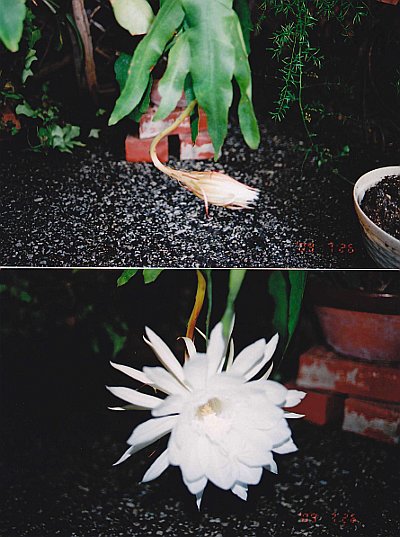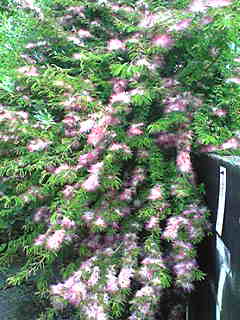July 26, 2009
This is the flower that last bloomed in 2007, 2 years ago.
It flowered again this year in the same pot. In the evening only buds were
seen (upper photo), but 5 hours later, the buds opened and were all in
bloom (lower photo). They exhibited its beauty in the darkness only for
3 hours at the depth of night. This flower is called "gekka bijin"
(lit. a beauty under the moon). It is Queen of the Night or Dutchman's
pipe cactus. Two years ago, a near-full moon was shining brightly over
the flowers; it was literally "gekka bijin". This year it was
flowering under a crescent moon through thin clouds. However, it was a
dark night and there was no moon shadow.
A single star in the dark sky
Gekka bijin are in bloom
But no moon will appear tonight
By whom do these beautiful white flowers want to be seen?
Many years ago, one lady used to come to my guitar lessons on a motorized
wheelchair from the northern end of Kochi City. She would park her wheelchair
in a corner of the flowering garden to relax. She passed away some years
ago. I thought that perhaps her soul bloomed into these flowers. I was
thinking of Girolamo Frescobaldi's "Aria con variazioni" , which
she loved.
July 23, 2009
Geisei Observatory was open to the public on the day of the
July 23 solar eclipse. About 50 people gathered around the observatory
up on the hill including reporters as well as school children just out
for summer holiday accompanied by their parents. They watched this rare
astronomical phenomenon with keen interest. Five staff members of the observatory
observed the eclipse in their individual ways.
At 10.55 just before the maximum eclipse the crescent sun
appeared in a gap of clouds for a brief moment and drew cheers from the
participants watching it at several places. Thin clouds reduced the glare
of the sun and the crescent sun was observed clearly with the naked eye.
The sound heard was not just the cheers from the humans watching the eclipse,
but uguisu, Japanese bush warblers, began chirping busily in the woods
nearby, perhaps sensing the changes in the surroundings. Toward the end
of the eclipse, the weather gradually improved.
The photographs below show the partial eclipse taken with
a 200mm telephoto lens and people watching it.
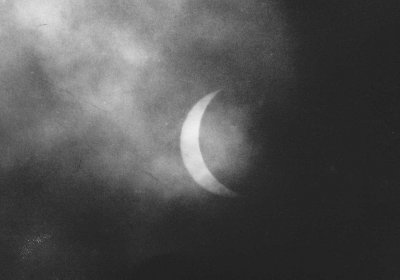
The partial eclipse
July 22, 2009. 10:55
Tsutomu Seki, Geisei Observatory
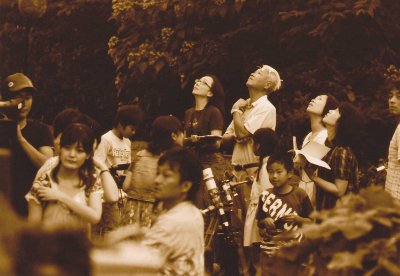
Participants watching the eclipse
Geisei Observatory
July 22, 2009
The public lecture presentation was held at Kochi City Cul-Port
for the first time
in 10 years. It was part of the natural science course series and the theme was the mechanism of the universe and astronomical bodies. The overwhelming majority of the audience was middle-aged and elderly men with a fewer women present. I hardly noticed students in the audience. Many years ago, any event related to astronomy and other sciences was attended mainly by students. Is it a sign of what is called "declining interest in science among younger generations"? Although we had a large audience, I felt something was missing.
The other speakers talked about the universe at an advanced
level, but I was impressed by the audience's serious attitude trying to
understand it. When the audience is seriously interested, the speakers
will feel comfortable and can develop their talk in a pleasing and desirable
way. I always think the good attitude of the audience brings out the best
of the speakers.
I talked for about 90 minutes without a question-and-answer
session, because I know there wouldn't be many worthwhile questions which
interest the majority of the audience. The speakers hope to have questions
which can be answered only by the speakers themselves; not the questions
whose answers can be found in books or from knowledgeable people.
Many years ago, there was an NHK program where a famous guitarist
performed and a small number of selected members of the audience asked
him questions. I was disappointed by very ordinary and self-benefiting
questions such as "Could you tell me how to play this particular part
of the music?" Many viewers would be hoping for good questions which
could make the performer define the essence of his development as a superb
performer.
I had a chance to talk with Prof. Okubo at the backstage,
who is the president of Kochi Women's University and chaired this public
lecture presentation. Prof. Okubo specializes in astronomy, writes papers,
and attends conferences overseas. He says he is often asked by astronomers
from foreign countries where he is from. He flattered me saying that he
would answer "I am from the country of Comet Ikeya-Seki" because
this would be much easier for them to understand than "I'm from Kochi
prefecture".
Below is a photograph of the keen audience seen from the
stage
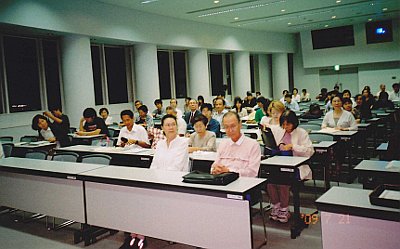
A view of the public lecture presentation at Cul-Port
July 14, 2009
The rainy season appears just about to end but still refuses
to go. I am not able to do any observing and my mind tends to wander around.
The Persian silk tree flowers in the garden are drooping
beaten by rain. These flowers seem to be patient and enduring, continuing
to flower in spite of the beatings by rain and trying to exhibit their
beauty. They are graceful flowers in the rain.
On the wartime radio we heard a song called "Ameni saku
hana" (flowers blooming in the rain) sung by Taneko Seki. Taneko Seki
was at the peak of her popularity at the time. She was one of the people
I endeared most, but all I could do these days was to listen to her beautiful
voice, as there was no television then. I could not figure out what sort
of person she was nor had a chance to see her face. Today, I guess very
few people will know the song "Minami no kuni no furusato" (my
hometown in the south) frequently sung at the height of the war.
In autumn the compound of Kurashiki Observatory became full
of colorful cosmos flowers. According to a book written by Mr. Minoru Honda,
Mr. Shigeki Okabayashi, who worked for the observatory, discovered a comet
in Leo in the eastern sky at 4:30 at the predawn of October 1 in 1940,
while conducting a search surrounded by cosmos flowers. It was the discovery
of Comet Okabayashi-Honda.
Incidentally, at the predawn of October 6, 1956, I put a
single cosmos flower in the chest pocket of my overcoat and walked up onto
the rooftop observing platform. This was the morning I discovered Comet
Crommelin in the constellation of Leo.
When autumn arrives and cosmos flowers bloom all over, I remember the time of my discovery and think "the observing season has come again..." Cosmos is my favorite flower.
July 11, 2009
The comparator is an instrument to measure the position and
dimension of a photographed comet or minor planet. It was also called an
"XY coordinate measuring instrument". It is not in much demand
today, however, because CCD observation and PCs have replaced them.
At the former Tokyo Astronomical Observatory, a large Mann
Comparator worth several tens of millions of yen was sitting idle. I heard
from a third party that it was now a white elephant and nowhere else to
be placed. In my December 28th diary entry last year, I wrote about Shimadzu
Corporation's photographic plate measuring instrument. It was priced at
500,000 yen around 1970, way beyond what you could afford. Around that
time I began photographic observation and wanted to do precise positional
measurements, moving away from rough sketch-based measurement. I tried
every possible avenue to get hold of the instrument, but in the end I just
had to give up.
In those days, observatories continuously engaged in precise
positional measurement of comets were limited to fewer than 10 professional
observatories in the world. My feeling was that, under these circumstances,
amateurs would be able to make great contributions in this field. However,
the astronomical community was conservative and there was a persistent
attitude among professional as well as amateur astronomers that amateurs
should not attempt precision measurement. I wonder why they could not have
foreseen the present state of positional measurement revolutionized by
amateur contributions. The lack of foresight may be the right word to explain
it.
In spite of all these, my dream came true in 1967. Starting
with measurement of bright minor planets, I began the precisen positional
measurement of Comet Ikeya-Seki 2 discovered in the same year. As expected,
it caused considerable reactions in Japan as well as overseas. As mentioned
in an earlier diary entry, Dr. Marsden of the Smithsonian quizzed Tokyo
Astronomical Observatory about what I was doing. Unlike negative responses
in Japan, he welcomed my involvement in positional measurement.
The home-made comparator I used was "a devise of ingenuity"
worth no more than 1500 yen. It was apparently so incredulous to others
that an amateur astronomer came to inspect it all the way from Tokyo. The
optical part of the instrument was a 25mm Kellner eyepiece on hand with
an Olympus precision micrometer (0.1mm graduated scale etched on a glass
plate) placed on its focal plane. It is a kind of scaled loupe. With this
simple instrument I made numerous positional measurements of comets and
the results were reported in the postcard size IAUCs issued by the Smithsonian.
Around the same time the SAO Catalog was published by the Smithsonian for
observation of artificial satellites, which turned out to benefit amateur
astronomers.
A few days ago, Comet Swift-Gehrels (64P/Swift-Gehrels),
which has an orbital period of about 9 years, was recovered earlier than
expected by Mr. Kenichi Kadota of Saitama prefecture. It was observed at
Geisei during the previous apparition of 1991. Looking at the original
photographic plate now, I can recall the difficulty of measurement owing
to the paucity of comparison stars. When photographed by a reflector in
particular, accurate measurement is difficult because of inadequate comparison
stars in its narrower field and off-axis coma aberration. However, with
the introduction of the GSC catalog, the problem was solved. I passionately
believe that the argument against amateurs' involvement in positional measurement
has been well countered by what amateurs have achieved.

The photograph below shows a Nikon comparator still in use with photographic film.
July 5, 2009
The birthplace of Ryoma Sakamoto is located near the streetcar
stop at Kamimachi. His home had been well preserved in the prewar era,
but was burned down during the air raids on July 4, 1945. As a school friend
of mine lived one house away to the west from Ryoma's home, one day we
walked into the house together to check it out. It was unoccupied and deserted.
On November 11, 1835 Ryoma was born there. I can picture
that the sky that night was spectacular with the famous Halley's comet
stretching across the sky. Although many tourists visit his birthplace
today, what's left there is a lone monument with a plaque which reads "the
birthplace of Ryoma Sakamoto" written by the former Kochi prefectural
governor.
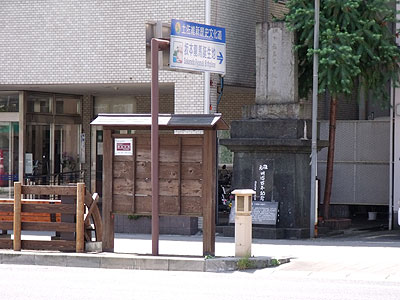
The monument for the birthplace of Ryoma Sakamoto
July 3, 2009
I went to Kochi Literary Museum near Kochi Castle to give
a public lecture today. I looked at the towering Kochi Castle for the first
time since I had named a minor planet after this castle. Bathed in the
morning sun, the castle appeared especially memorable and meaningful to
me.
On October 12, 1961, I discovered my first comet and came
to a telegraph office at the foot of the castle. Having sent a discovery
telegram to Tokyo at 6 am, I breathed a sign of relief, then saw the awe-inspiring,
magnificent view of Kochi Castle shining in the morning sun in the northern
sky. Looking at the castle with the joy of accomplishing my life-long aspiration,
I found its white walls appearing graceful and almost divine. I remembered
the deep emotion I felt that day and named a minor planet Otakasakajyo,
the old name of Kochi Castle.
Over 100 "mature age" people gathered in the Museum's
hall. "Silver Universities" (an equivalent of University of the
Third Age) and "senior citizens classes" are common these days.
Interestingly, women are keener than men in these organizations and, among
those who gathered in the hall, 90% of them were women. I began my talk
with the topic of the total eclipse on July 22 and continued with various
stories about the stars. Generally, after talks like this, there are always
some people coming up to you to introduce themselves, whom you would not
even dream of meeting, and lively conversation about good old days and
stories of unusual events ensue. As I anticipated, one elderly lady close
to 70 walked straight up to me and said, "Do you remember me? My name
is Nakamura. I used to be a narrator for planetarium shows 60 years ago."
Yes, I do remember her. She was one of the several women
who had narrated for planetarium shows. We volunteers built a home-made
planetarium machine and conducted the shows coinciding with the time of
the second Nangoku Expo. Her beautiful voice echoing in the dome still
lingers in my ears. Suddenly, all the memories began spinning furiously
in my head, memories of the times when we built the planetarium experiencing
great difficulties, happiness, and disappointment. The episodes about those
days have been written in "My 50 years with comets" in a few
installments at my website under the title "The planetarium and a
submarine". It is filled with bizarre stories.
This Nakamura -san had a male cousin Norio Kubouchi, who was in the same
year as me at junior high school. I was worried about him, having lost
track of him soon after we graduated. I was stunned when I learned later
he had died from illness. He had lived close to our home and in my second
year of high school we played and studied together. He was one of the few
friends of mine with whom I had shared the experience of the massive air
raids over Kochi City on July 4, 1945, and the Great Nankai Earthquake
in December the following year.
His father was a Christian minister and a part of his home was a small
church. I remember that, when I was observing on the early morning of one
Christmas Day, I heard a choir singing the hymns and felt intense spiritual
sensation, while a star cluster of thousands of light-years away was shining
in the eyepiece.

Kochi Castle and its main gate

